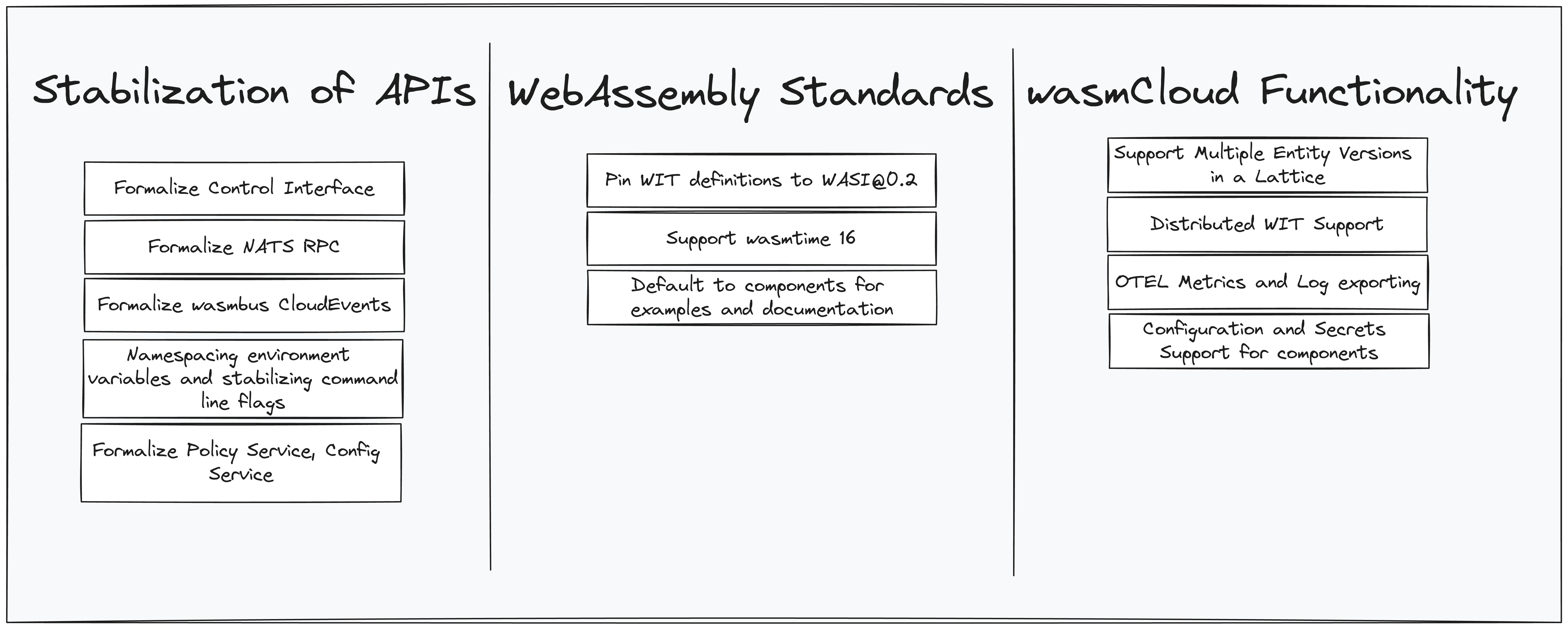Road to 1.0: wasmCloud, a Refreshed Roadmap

Last week, we looked back at how far the wasmCloud project has come. In particular, the progress made in the last few months since the Q3/Q4 roadmap was published. We're nearing the release of wasmCloud 1.0; our stable, standards-led and production-ready release due to be unveiled in early 2024. As we reach this major milestone, we're excited to unveil a refreshed roadmap for Q1 2024.
In our second post in our Road to 1.0 series, we'll review our revised goals, feature set and the final tasks in the plan to get wasmCloud to 1.0. The fresh roadmap is available on GitHub Projects; this is a snapshot of the current state of the project, and will evolve as the project progresses. In the coming weeks, we'll share a host of new documentation, RFCs and guidance on all things wasmCloud 1.0. In the meantime, let's take a look at how our goals and features have evolved.
Goals and Features
Our Q3/Q4 roadmap focused heavily on the desire to embrace common Wasm and cloud-native standards, and to make the developer experience a genuine delight. These aspirations stay in focus as we push to release wasmCloud 1.0 and so it won't be a surprise to see our goals remain, largely, unchanged.
- A core ongoing tenet of is to provide a seamless developer experience for building, testing, and deploying WebAssembly components.
- We recognise the importance of being a completely vendor-agnostic development environment and so our goal is to enable developers to build features without vendor lock-in, platform specific dependencies, or language constraints.
- The completion of WASI Preview 2 and the Component Model is on the horizon and so we're committed to capitalizing on as many WebAssembly standards as possible, and making them default within wasmCloud. In particular, dropping wasmCloud with a stable set of WIT definitions will make true language interoperability a reality.
- We're also committed to leveraging common cloud-native standards wherever possible, to bring the kind of enterprise tooling to Wasm that engineers expect (OAM, OCI, CloudEvents, OTEL Metrics, Logging and Tracing.)
On the feature front, above all, our priority is to make it as easy as possible for developers to work with components and to move projects seamlessly from dev to prod. As such, our fresh feature set is designed to do just this.
- Declarative WebAssembly Orchestration
- Seamless Distributed Networking
- Vendorless Application Components
- Completely OTEL Observable
- Defense-In-Depth Security By Default
Step-By-Step: Refreshed Roadmap
The GitHub Roadmap is updated to include a new view, "1.0 (Q1 2024)", which will track all of the work to be included in the 1.0 release. First priorities are to standardize our APIs and user interaction points and, as a WASI Preview 2 and the component model reach completion, to add support for WIT and WASI APIs. The good news is, changes are already in flight to bring the latest WIT definitions for WASI, and to align with Wasmtime 16. All this brings additional functionality and improvements to the user experience.
The exciting part? Our community has the opportunity to contribute to the final stages of development, so, we've pulled together a handy list of RFCs and key tasks due for completion before we release 1.0.
- Formalize the wasmCloud Control Interface
- Support Multiple Entity Versions within a Lattice
- Host Metrics
- Distributed WIT Support (RFC forthcoming)
- Support wasmCloud runtime configuration and secrets (RFC forthcoming)
- Simplify Link Definitions into Runtime Linking without configuration
- Make WIT and components the default for examples and documentation, including instructions for unknown source languages
There are many smaller tasks that are included as well, such as namespacing our environment variables, that are perfect if you're looking to contribute to this milestone! Review our Contributing Guide for more information, and come join us on Slack to chat with the team the wider community.
Looking Ahead to Incubation
Because wasmCloud 1.0 will be stable, standards-led and production-ready, it makes sense for us to approach official incubation status within the CNCF. Achieving incubation status shows we align to a standardized process of development, and that we have active contribution from stakeholders in a host of different industries. This is the sign of a project that is seeing healthy growth and cross-community support. Gaining incubation status will allow us to benefit from the CNCF's considerable resources, and get wasmCloud in the hands of more developers. Developers and contributors are, in turn, confident they are using a stable and sustainable platform.
Take a look at the full roadmap page in docs for more detail and practical adjustments we're making to nomenclature and task tracking. Don't forget, also, to join the wasmCloud community meetings every Wednesday at 1pm ET to hear the latest news. We're live every wasmCloud Wednesday on YouTube, X, and LinkedIn.
